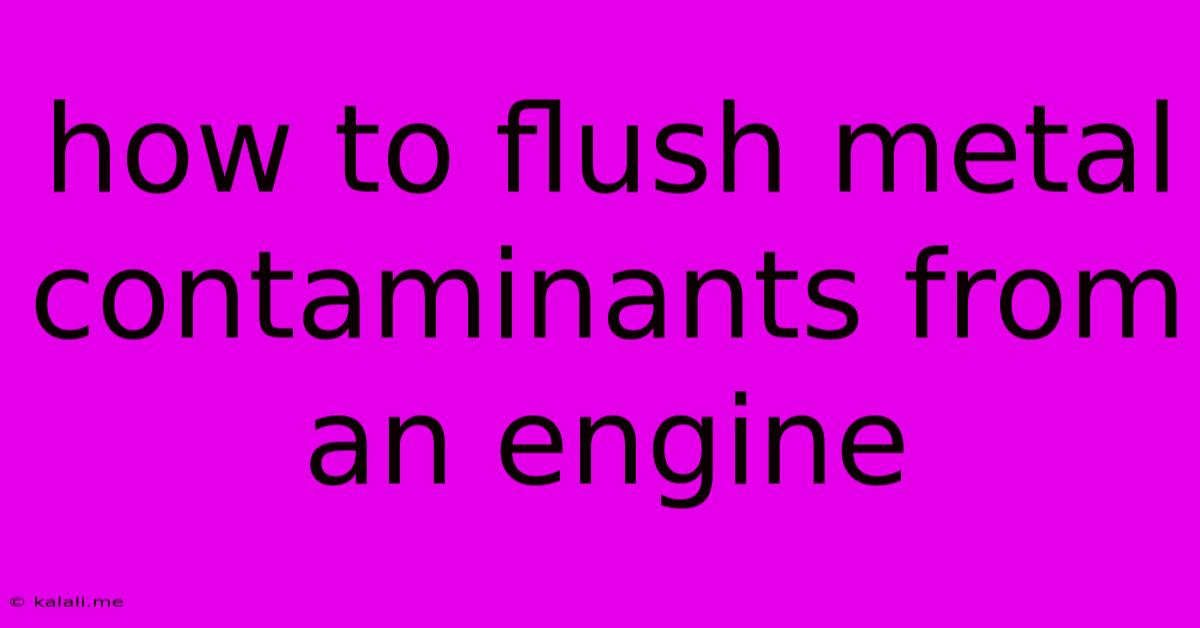How To Flush Metal Contaminants From An Engine
Kalali
May 25, 2025 · 3 min read

Table of Contents
How to Flush Metal Contaminants from an Engine: A Comprehensive Guide
Meta Description: Learn how to effectively flush metal contaminants from your engine to improve performance and extend its lifespan. This comprehensive guide covers different flushing methods, precautions, and when professional help is necessary.
Engine oil is the lifeblood of your vehicle's engine, protecting vital components from wear and tear. Over time, however, the oil itself can become contaminated with metal particles, sludge, and other debris resulting from normal engine wear and tear. These contaminants can lead to reduced engine performance, increased fuel consumption, and ultimately, engine failure. This guide explores various methods for flushing metal contaminants from your engine, helping you maintain peak performance and longevity.
Understanding Metal Contaminants in Engine Oil
Before diving into flushing methods, it's crucial to understand what causes metal contamination. Normal engine operation creates microscopic metal particles from the friction between moving parts like pistons, cylinders, and bearings. These particles, along with varnish and sludge, accumulate in the oil, degrading its lubricating properties. Severe engine damage, such as a spun bearing, can introduce significantly larger metal particles into the system.
Identifying the presence of excessive metal contaminants often involves a used oil analysis. This specialized test analyzes a sample of your used engine oil to determine the concentration of various metals, providing insights into the condition of your engine's internal components. While not always feasible for the average car owner, it's an invaluable diagnostic tool.
Methods for Flushing Metal Contaminants
Several methods exist for removing metal contaminants from your engine, each with its own pros and cons. Choosing the right method depends on the severity of the contamination and your comfort level with auto maintenance.
1. Engine Oil Change with High-Mileage Oil: This is the simplest and most common method. Using a high-mileage oil designed for older engines can help suspend and remove some contaminants during the next oil change cycle. These oils often contain detergents and dispersants formulated to clean accumulated sludge and deposits more effectively than standard oils.
2. Engine Flush (Chemical Flush): Engine flush products are commercially available and are designed to dissolve and remove sludge and varnish buildup. It's crucial to follow the manufacturer's instructions precisely, as improper use can damage your engine. Many mechanics advise against this method due to potential issues with dislodging large deposits and damaging seals.
3. Oil System Cleaning with Specialized Additives: Some oil additives claim to clean and protect your engine's oil system. However, the effectiveness of these products varies widely, so thorough research and selecting a reputable brand are crucial. Always check reviews and ensure the additive is compatible with your engine type and oil.
Precautions and Considerations
Regardless of the chosen flushing method, several precautions are necessary:
- Check your owner's manual: Consult your vehicle's owner's manual before attempting any engine flush procedure. Some manufacturers discourage or prohibit the use of engine flushes.
- Use the correct oil: Always use the correct type and grade of motor oil specified by your vehicle's manufacturer.
- Avoid over-flushing: Excessive flushing can be detrimental to your engine. Follow the manufacturer's recommendations carefully.
- Inspect the drained oil: Examine the drained oil for excessive metal particles or sludge. This can help assess the effectiveness of the flushing method.
When to Seek Professional Help
If you suspect significant engine damage or have concerns about the condition of your engine, it's best to consult a qualified mechanic. They can perform a thorough inspection, including a potential used oil analysis, and advise on the most appropriate course of action. Ignoring significant metal contamination can lead to catastrophic engine failure.
This guide provides a general overview of how to flush metal contaminants from your engine. Remember to always prioritize safety and consult a mechanic if you are uncertain about any aspect of this process. Regular oil changes and proper maintenance are the best ways to prevent significant metal contamination and ensure your engine's long-term health.
Latest Posts
Latest Posts
-
Water Based Polyurethane Over Oil Based Polyurethane
May 25, 2025
-
Use Jq To Replace Value In Json
May 25, 2025
-
Where To Store Stuff In Skyrim
May 25, 2025
-
How Many Cups From A Pound Of Coffee
May 25, 2025
-
How To Keep Meringue From Shrinking
May 25, 2025
Related Post
Thank you for visiting our website which covers about How To Flush Metal Contaminants From An Engine . We hope the information provided has been useful to you. Feel free to contact us if you have any questions or need further assistance. See you next time and don't miss to bookmark.